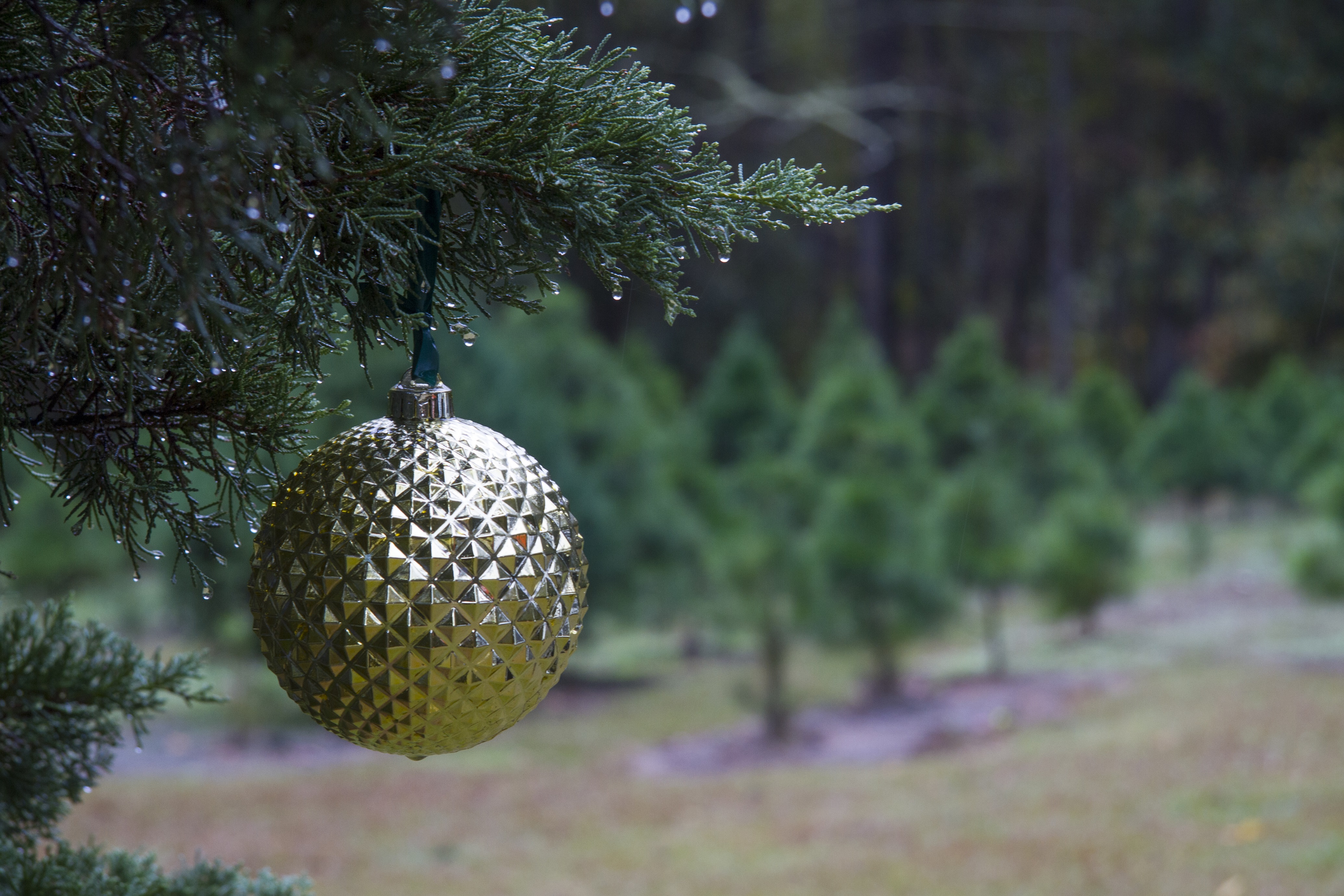
by hollyober | Dec 16, 2016

Christmas trees can provide benefits to wildlife long after they have served as holiday decoration indoors. Credits: IFAS photo database.
Americans purchased approximately 30 million live Christmas trees last year. If you plan to have a live tree this winter, and you’re wondering what you could do with your tree once it has finished its role as holiday decoration in your home, read below. Rather than simply dragging your tree to the curb for the waste disposal truck to pick up, you could prolong the life of your holiday tree by repurposing it to benefit wildlife.
YOUR TREE COULD PROVIDE FOOD FOR WILDLIFE
Many of the needles may have dropped from your Christmas tree as it dried out while indoors, but the branches should still be intact. This means your tree could be used as a frame to present food for wildlife. After removing your indoor decorations, consider propping the tree up in your yard (perhaps using the same stand you used indoors), and adorning the branches with food enjoyed by wildlife visitors. Some low-budget options include mesh bags filled with bird seed (black oil sunflower seed, safflower seed, and thistle (nyjer) are favorites of many common backyard birds), pine cones smeared with peanut butter, home-made suet cakes, and strings of fruit such as apple slices, orange slices, or grapes. If you choose this option, beware that you may attract not only birds, but mammals such as squirrels, raccoons, opossums, and others.
If you’d like to watch your wildlife visitors, be sure to attach the food items with string so that the animals must eat the food at the site of the tree rather than carrying it away to eat or store elsewhere out of view. Consider using a biodegradable string (i.e., cotton) to secure the food items to your tree so you can eventually compost the tree without worrying about needing to remove the string.
YOUR TREE COULD PROVIDE SHELTER FOR WILDLIFE
If you’re tired of seeing your holiday tree in its upright position, consider taking it outdoors, laying it down, and heaping other vegetative debris loosely on top to form a ‘brush pile’. Brush piles are mounds of woody vegetation created specifically to provide shelter for wildlife.
The lower portions of a brush pile can offer cool, shaded conditions that allow small mammals such as rabbits to hide from the weather and from predators. Meanwhile, the upper portions can serve as perch sites for songbirds. The entire pile may be used as resting sites for amphibians and reptiles. In yards with few understory trees or shrubs, and at times of year when many trees and shrubs have limited foliage, these brush piles can provide much-appreciated cover for many kinds of wildlife.
YOUR TREE COULD PROVIDE SHELTER FOR FISH
Your retired Christmas tree could be used to make long-lasting habitat improvements for fish. In artificial ponds with little submerged vegetation, the addition of one or more Christmas trees could upgrade the quality of refuge and feeding areas for fish. Small fishes may hide among purposely submerged Christmas trees for protection, and larger fishes may follow them. If you’ve got an artificial pond on your property, consider adding discarded trees to create a place where fish can hide and find food, and also to concentrate fish for angling. Simply secure a cinder block to your holiday tree using heavy wire or thin cable and place it far enough from shore that water covers the top of the tree by a couple of feet. When constantly submerged, Christmas trees can persist for many years underwater.
Not only can your tree offer enjoyment to you when decorated with lights and ornaments indoors, but it can also allow you to provide post-holiday gifts to the wildlife and fish on your property.
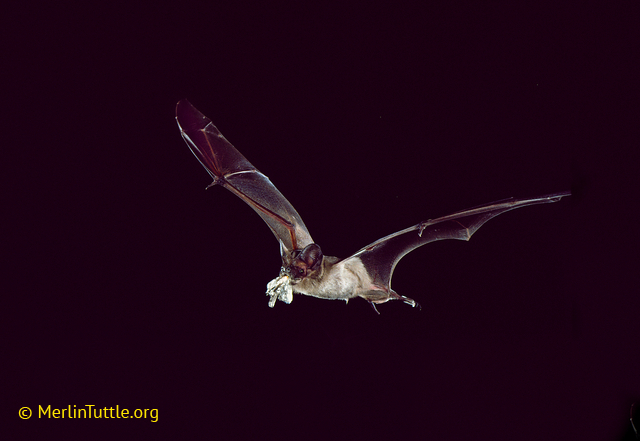
by hollyober | Oct 22, 2016
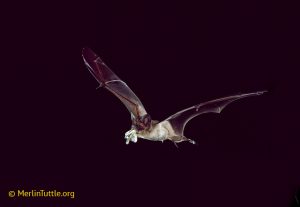
Brazilian free-tailed bat (Tadarida brasiliensis) eating a corn earworm moth (Helicoverpa zea).
If you think you’d prefer a world without bats, we present to you three reasons to reconsider. Most negative stereotypes about bats are untrue. The reality is that bats benefit us in numerous ways. Here are a few facts that may convince you we should be thankful for bats rather than fearful of them.
1. INSECTS WOULD BUG YOU MORE IF WE HAD NO BATS
Over two-thirds of the 1,240 species of bats that roam the earth’s skies feed on insects. These aerial acrobats cruise over forests, grasslands, waterways, and crop fields, assisting us by consuming nighttime insects. Bats collect insects using a variety of innovative approaches: some scoop them from the air with their wing or tail membrane and transfer them to their mouths; others nimbly pluck insects off surfaces such as leaves, tree trunks, or even water. These bats are our allies, as they drastically reduce the number of pests that would otherwise bite us or damage our crops. It’s estimated that bats help North American farms save around $23 billion a year. If all bats were lost, the resulting damage to crops due to the insects bats formerly kept in check is estimated to be $74/acre across the US.
2. SOME FOODS AND DRINKS MIGHT BECOME RARE IF WE HAD NO BATS
If you like tropical fruits like mangoes, papayas, guavas, bananas, or figs, you should be thankful for bats. Many bats in the tropics and sub-tropics pollinate and disperse seeds in ecosystems ranging from deserts to rainforests. Bats in the desert visit columnar cacti and agaves, ensuring pollination of the plants responsible for making tequila. Bats in the rainforests help regenerate new forests and ensure availability of many locally-consumed and highly-nutritious fruits.
3. BATS CAN HELP US SOLVE MEDICAL PUZZLES
Bats possess many unique biological adaptations that hold clues vital to solving human health issues. Bats have already made notable contributions to the medical community. The special blood thinning enzymes found in the saliva of vampire bats has helped us understand how to prevent blood clotting during open-heart surgery. The adaptations bats have for seeing in the dark are being studied to see if they could provide insight useful for assisting people who have limited vision.
Despite the many ways bats help us, they remain misunderstood by many. Fear of bats, called chiroptophobia, is the result of negative stereotypes about bats. Most of these stereotypes are downright untrue. First, there’s a common belief that bats get caught in people’s hair. This is highly unlikely: if a bat is agile enough to catch an insect the size of a gnat in flight, it can certainly steer clear of a human head. Second, there’s a common fear that all bats have rabies. In fact, rabies is quite rare among bats, and much more common among raccoons and foxes in Florida. Third, despite the portrayal in movies of bats as aggressive towards humans, bats are in reality not likely to bother people. In fact, they’re generally far more afraid of you than you are of them.
If you’d like to help bats (and perhaps get some free control of insect pests in your area), consider building or buying a bat house for your property. Also consider leaving dead and dying trees in your yard if they’re not a safety hazard, avoid trimming dead fronds off your palm trees, and retain Spanish moss. All of these locations (tree cavities, dead palm fronds, and Spanish moss) offer roosting habitat for bats. By promoting bat habitat, you may boost local bats and find you have fewer insect pests nearby.

by hollyober | Apr 8, 2015
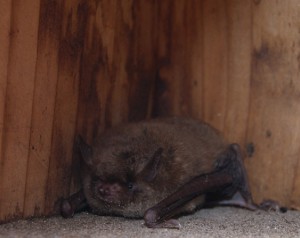
Bats are extremely beneficial, but they can be unwelcome guests when they choose to roost indoors, like this evening bat. Photo credit: LeiLani Davis.
Bats typically sleep during the day in natural structures such as trees and caves. In areas with few natural roost structures, bats may instead choose to spend their days in buildings.
Bats are beneficial because each bat consumes hundreds of insects per night. Bats save farmers billions of dollars annually by substantially reducing the abundance of insect pests. However, they can be unwelcome guests when they choose to live in buildings. The safe, humane, effective way to coax a colony of bats out of a building permanently is through a process called an ‘exclusion’.
A bat exclusion is a process used to prevent bats from returning to a building once they have exited. It is accomplished by installing a temporary one-way door. This one-way door can take many forms, but the most tried-and-true is simply a sheet of heavy plastic mesh screening (with small mesh size) attached at the top and along both sides of the sheet, but open on the bottom. The one-way door should be attached over each of the suspected entry/exit points bats are using to get in and out of the building.
It is illegal to harm or kill bats in Florida, but exclusions from buildings are allowed if you follow practices recommended by the Florida Fish and Wildlife Conservation Commission (FWC). According to Florida law, all bat exclusion devices must be left in place for a MINIMUM of 4 consecutive nights with temperatures above 50 o F before each entry point can be permanently sealed to prevent re-entry by bats. Also, it is unlawful in Florida to attempt to exclude bats from a building between April 15 and August 15, which is bat maternity season. This is when female bats form colonies and raise young that are unable to fly for their first few weeks of life. If bats were excluded during this time period, young bats (called pups) would die indoors.
For more information on how to conduct a bat exclusion, check out this video that features interviews with bat biologists from the University of Florida, FWC, and the Florida Bat Conservancy: How to Get Bats out of a Building.
For additional information on Florida’s bats, visit University of Florida’s bat advice or FWC’s bat website.
Remember, bat maternity season in Florida runs from April 15 to August 15. If you have a colony of bats roosting indoors that you want to exclude, you must either act quickly or else wait until the middle of August to coax them out.
by hollyober | Mar 21, 2014
Spring is a dynamic time for wildlife. If you enjoy watching nature, now is a fantastic time to get outdoors to see some interesting activity. March is also one of the best times of year to do some active management on your property to enhance the habitat you provide for wildlife.

Purple martins select nest sites during February-March in the Panhandle, so now is your last chance to make martin housing available. Photo by Sarah Friedl.
Because of its position just north of the Gulf of Mexico, Florida is the first landmass where many exhausted birds can rest after migrating northward to the U.S. from South and Central America. The strenuous northward migration is now underway for many species of birds. That means this is one of the most interesting times of year to visit your local natural area with a pair of binoculars. A trip to St. Marks National Wildlife Refuge or your nearby State Park or Wildlife Management Area could result in a glimpse of several migratory species that are rarely seen in the area.
Purple martin scouts began their migration from South America to the Panhandle nearly four weeks ago. If you have purple martin housing and have not yet cleaned out last year’s nesting material, now is your last chance to do this. Wash out your housing with soap and water. If you take your martin housing indoors during the fall and winter to protect it from harsh weather or if you plug the entrances to prevent use by other species, don’t wait any longer to make your housing available to martins or you’ll miss out on attracting them this year. Older martins remain extremely faithful to the exact same nesting site, so will want to return to the housing you provided them last year. In contrast, yearling martins that hatched last summer tend to return to the same area they were born in Florida about 4-6 weeks later than the older scouts. These yearling birds are generally the ones who adopt new housing and start new colonies. Therefore, this week is the ideal time to put up new purple martin housing in the Panhandle.
Eastern bluebirds are resident all year round, but March is when they begin nesting in the Panhandle. Because bluebirds have a habit of nesting several times each year, it is possible that birds will adopt new houses erected later in the spring. However, the sooner you make new bluebird houses available, the greater the chances you’ll attract nesting birds. When deciding where to locate new bluebird houses, remember that bluebirds are territorial and will not let another bluebird nest within ~100 yards of a nest site they’ve already chosen.
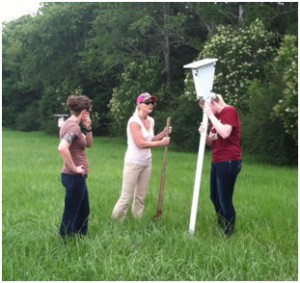
Bluebirds nest several times each year, so you can install a new bluebird house anytime during the spring, although February-March is ideal. Photo by Holly Ober.
For more information on attracting birds, check out this article on Purple Martins or this one on Cavity Nesting Birds. Or contact your county’s UF/IFAS Extension Office.
 Author: Holly Ober – holly.ober@ufl.edu
Author: Holly Ober – holly.ober@ufl.edu
I am an Associate Professor and Extension Specialist in the Department of Wildlife Ecology and Conservation. My research covers wildlife ecology, habitat management, and identifying creative ways to cope with nuisance wildlife.









